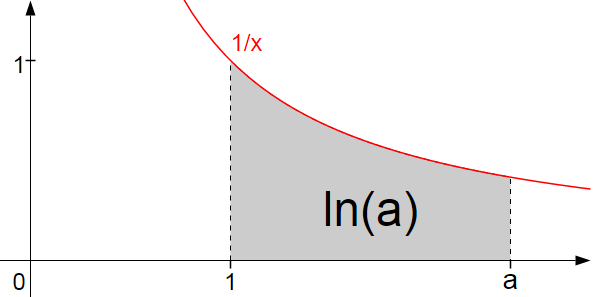Series to Ad Infinitum part III
 1
⋅
2
1
−
2
⋅
3
1
+
3
⋅
4
1
−
⋯
=
?
1
⋅
2
1
−
2
⋅
3
1
+
3
⋅
4
1
−
⋯
=
?
Answer up to 4 decimal places.
Image Credit: Wikipedia Natural Logarithm by W. Muła
The answer is 0.3862.
This section requires Javascript.
You are seeing this because something didn't load right. We suggest you, (a) try
refreshing the page, (b) enabling javascript if it is disabled on your browser and,
finally, (c)
loading the
non-javascript version of this page
. We're sorry about the hassle.
3 solutions
Sir , I'am just little extending your solution , because i enjoyed in solving this question. So I'am just sharing it. :)
S = r = 1 ∑ ∞ ∫ 0 − 1 r x r d x S = − r = 1 ∑ ∞ ∫ − 1 0 r x r d x S = − ∫ − 1 0 ( r = 1 ∑ ∞ r x r ) d x y = r = 1 ∑ ∞ r x r d x d y = r = 1 ∑ ∞ x r − 1 = 1 + x + x 2 + . . . . . . ( G P ) d x d y = 1 − x 1
Now Integrating and remove constant of integration by putting initial values : y = − ln ( 1 − x ) S = − ∫ − 1 0 − ln ( 1 − x ) d x = ∫ − 1 0 ln ( 1 − x ) d x 1 − x = t S = ∫ 1 2 ln t d t = [ t ln t − t ] 1 2 = ln 4 − 1
Log in to reply
Great work, Deepanshu. I think that d x d y = 1 − x 1 ⟹ y = − ln ( 1 − x ) + c , but the elegance of your proof remains intact. :)
Log in to reply
thanks Sir , I found my typing mistake , I intially eat a negative sign , But thanks sir Now I have corrected that :)
Nicely done (Y)
Perhaps it would be clear to take two fractions at a time and show that you can change it to − 1 + n = 1 ∑ ∞ n 2 − n + 1 2 . I think ( − 1 ) n coefficients are nice and succinct, but only in the right context.
1 ∗ 2 1 − 2 ∗ 3 1 + 3 ∗ 4 1 + . . . . = 1 − 2 1 − 2 1 + 3 1 + 3 1 − 4 1 + . . . .
= 2 ( 1 − 2 1 + 3 1 − 4 1 + . . . . ) − 1 = 2 l n 2 − 1 = l n 4 − l n e = l n e 4 = 0 . 3 8 6
Just by looking the series I did remember the approximation of
y = Ln (1+x) = x -x^2 + x^3/3 -x^4/4 +...+(-1)^n-1(x^n/n)
valid for the interval -1<x<=1.
In our case x =1 and coincides with the upper limit, so it will render the solution Ln(1+1)
This series can be written as
n = 1 ∑ ∞ ( − 1 ) n + 1 ( n 1 − n + 1 1 ) =
1 + 2 ∗ n = 2 ∑ ∞ n ( − 1 ) n + 1 =
1 + 2 ∗ ( ln ( 2 ) − 1 ) = 2 ln ( 2 ) − 1 = 0 . 3 8 6 to 3 decimal places.
Note that the alternating harmonic series n = 1 ∑ ∞ n ( − 1 ) n + 1 = ln ( 2 ) .